French painter Paul Cézanne is known as the father of modern painting.
He is also known for his significant influence on many artists who followed in his footsteps, including Picasso, Matisse, and other cubist painters.
In this issue, we will take a bird's eye view of Cézanne's life and painting career.
Who is Paul Cézanne?
Cézanne's Early Life
Cézanne was born in Aix-en-Provence, a city in the south of France located on the opposite side of the country from Paris in northern France. He was born into a wealthy family that owned a well respected local bank.
In secondary school, he met Emile Zola, who would become his best friend. Zola was born in Paris, had lost his parents, was an outsider in Aix, and was bullied by his classmates. Cézanne later recalled an episode in which he was beaten up by his classmates for talking to Zola, who broke the rules of the village and presented him with a basket of apples the next day.
Together with another boy, Batistain Bayle (English version) (later an astronomer), the three became close friends and bonded.
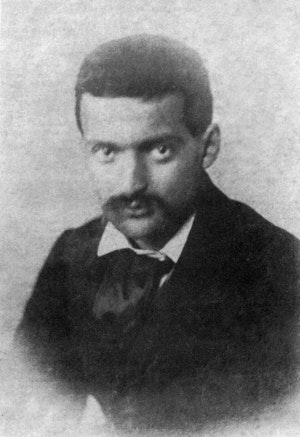
Photo taken circa 1861 (around age 22).
His father, Louis-Auguste Cézanne, was strict and sent his son to law school at the University of Aix.
However, Cézanne, who had trained in drawing since high school, was torn between his law studies and his painting studies.
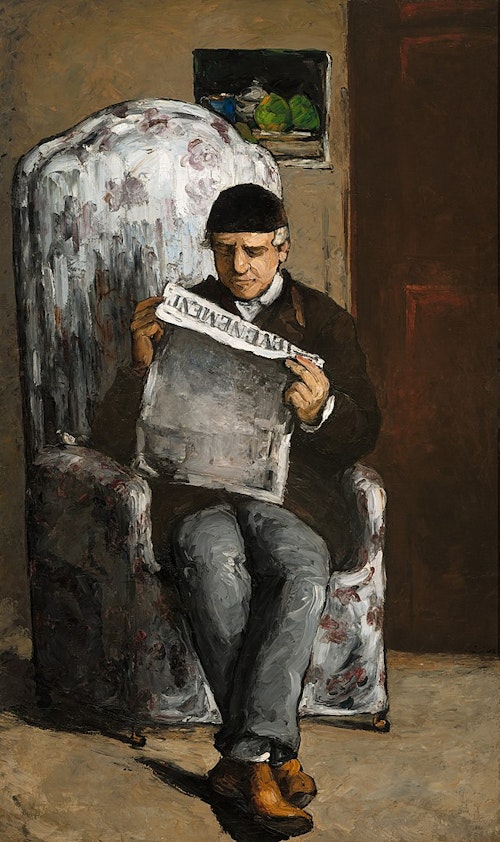
Father of the Painter Reading the "Révenuemant" paper, 1866
In 1858, Zola left for Paris. Cézanne and Zola began a correspondence in which they discussed various topics. Around this time, Cézanne, who had become disinterested in studying law and was neglecting his university studies, confided to Zola his desire to become a painter.
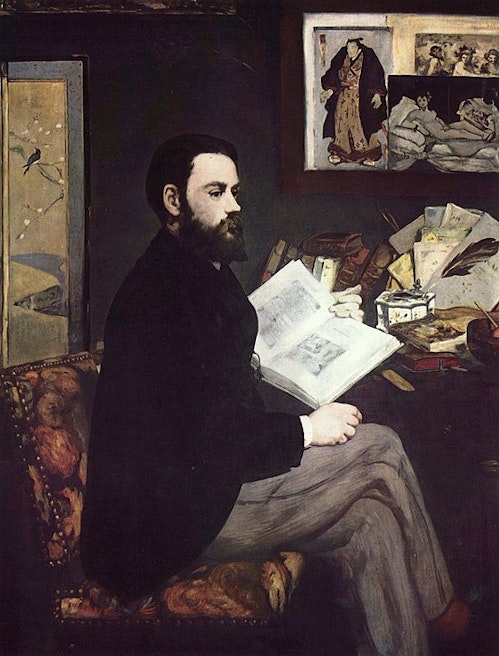
Manet, Portrait of Emile Zola (1868)
Starting Out as a Painter
At Zola's urging, Cézanne dropped out of the law department of Aix University and went to Paris to study painting. Unable to gain admission to the Ecole des Beaux-Arts, the elite art school of the time, he began attending the Académie Chouais. It was here that he met such figures as Pissarro and Guillaumont.
However, he did not fit in with the people who laughed at his provincial behavior, and he lost confidence in his own talent as a painter, so he returned to Aix.
In Paris, he frequented the Louvre to watch and steal techniques from the masters of the past. He was influenced by the Romantic Delacroix, the realist Courbet, and Edouard Manet.
Many of his works from this period were dark and Romantic in tone.
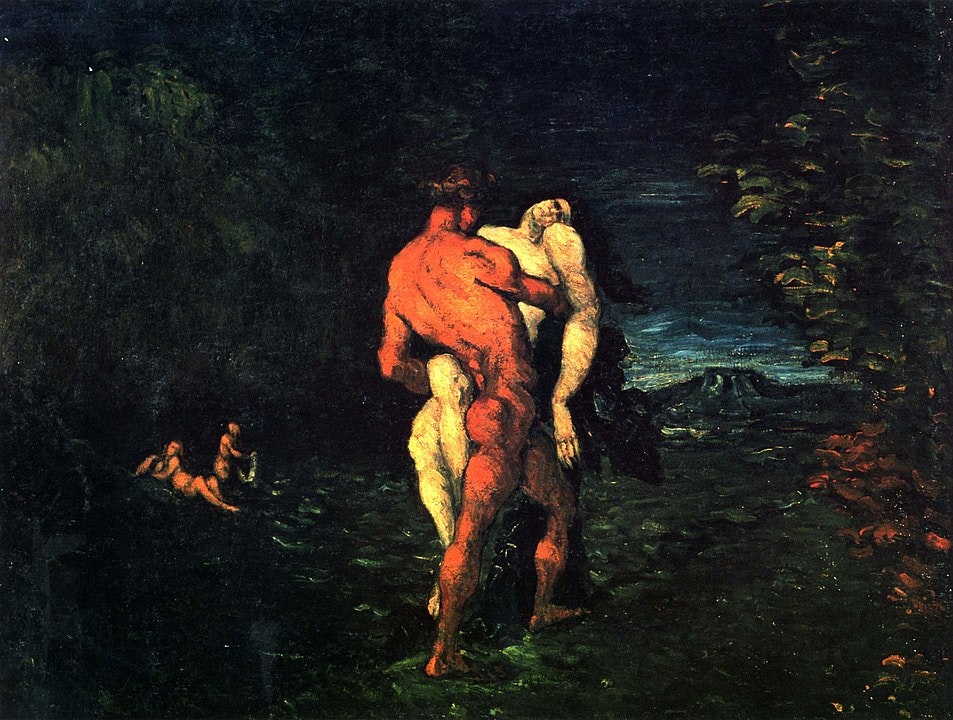
Plunder, 1867
Cézanne did not fit in with the Parisian art world
He exhibited every year at the Salon, the gateway to success in the French art world at the time, and despite the enthusiastic support of Charles-François Daubigny, one of the judges, he was continually unsuccessful.
He also joined his friends Zola and Manet, who were establishing themselves as art critics, at the Café Gerbois, where they were regulars, but he says he did not fit in with the urban, witty conversation that ensued.
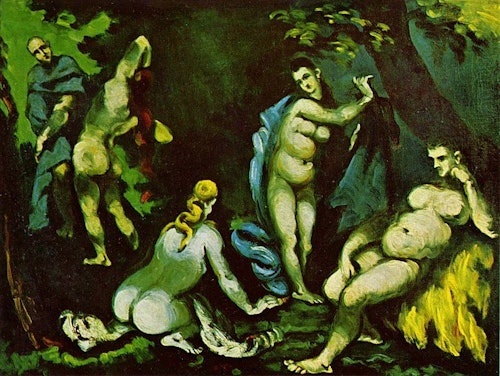
The Seduction of St. Antoine, 1870
Encounter with Impressionism
In 1872, Cézanne was undergoing many changes in his life.
He and his wife, Hortense Fiquet, whom he had met a few years earlier, had a son, Paul, and he returned to Paris, where the civil war in the Paris Commune had ended and the republic had returned.
He became friends with Pissarro and also with Paul Gachet, a doctor who was an amateur painter. Pissarro also introduced him to Julien Tanguy, aka Grandpa Tanguy, who opened a store in Montmartre, Paris, and he became a great admirer of Cézanne's work.
It was during this period that Cézanne learned from Pissarro techniques such as brushstroke division, and his paintings gained brightness. He later spoke of his Impressionist influences: "I, too, have been influenced by the Impressionists.
I, too, was an Impressionist, for all intents and purposes. Pissarro had a tremendous influence on me. But I wanted to make impressionism as solid and lasting as museum art.
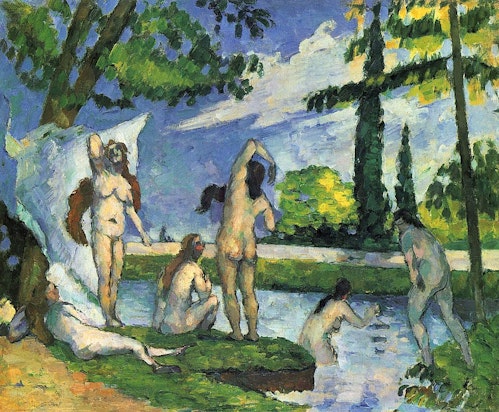
Bathing Woman, 1875-77
Response to the Third Impressionist Exhibition
Cézanne's participation in the first Impressionist exhibition in 1874 was severely criticized.
One of Cézanne's paintings, "Moderne Olympique," was also criticized sarcastically. Zola also contributed an article to the newspaper in defense of the exhibition.
Another work exhibited, "The Hanging House," was sold for the high price of 300 francs. Cézanne confessed his pride in the respectable sale of one of his paintings in a letter to his mother.
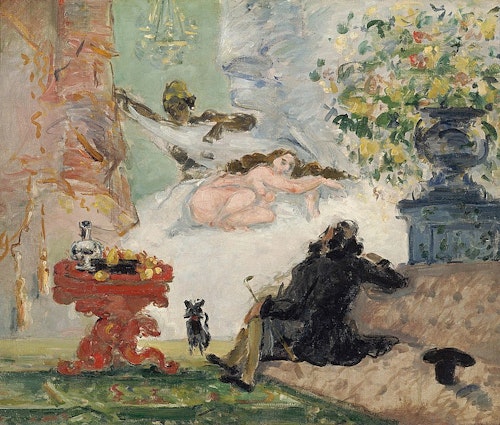
Moderne Olympia, 1873
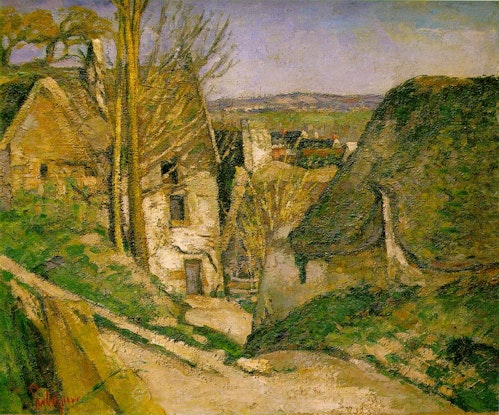
The Hanging House at Auvers, 1872-73
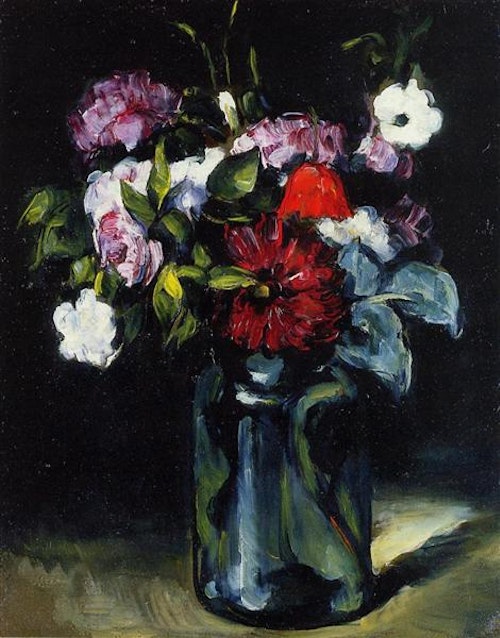
Flowers in a Vase, 1873
In 1877, Cézanne exhibited sixteen paintings at the Third Impressionist Exhibition, and although he was criticized as before, he began to receive a noticeable amount of critical acclaim for his work.
He began to demonstrate his ability as a "painter of color."
Departure from Impressionism
Gradually, Cézanne began to feel dissatisfied with the Impressionist approach, which tended to focus only on light that shifted with time and neglected the solid presence of the subject.
Cézanne himself returned to his hometown of Aix, although he maintained friendships with Monet, Renoir, and Pissarro.
Despite the volatility within the Impressionist movement, including a growing feud between Monet, Renoir, and Degas, Cézanne continued to work in Aix.
In 1886, Zola published his novel, Opus. The novel depicted the artistic failures of its protagonists, painters Claude Lanthier, who were seen as models for Cézanne and Manet.
It is commonly believed that the novel led to the breakdown of the friendship between Cézanne and Zola, but it is now proposed that it was rather the romantic relationship over Jeanne Rosulo, a woman employed by the House of Medan (Zola's villa), that distanced the two men.
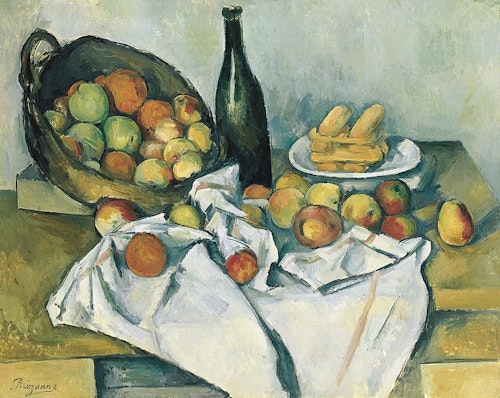
Still Life with a Basket of Apples, 1890-94
Cézanne, a solitary painter
Cézanne continued to paint, using Mount Sainte-Victoire and other mountains as motifs, but his paintings were not well understood by the public. His paintings were exhibited in an inconspicuous place at the Paris Exposition, but did not receive much of a response.
However, Cézanne was highly regarded among avant-garde painters, and was admired by Gauguin and other Symbolist painters.
Around 1890, age and diabetes made it difficult for him to work outdoors, and he shifted his emphasis to portraits.
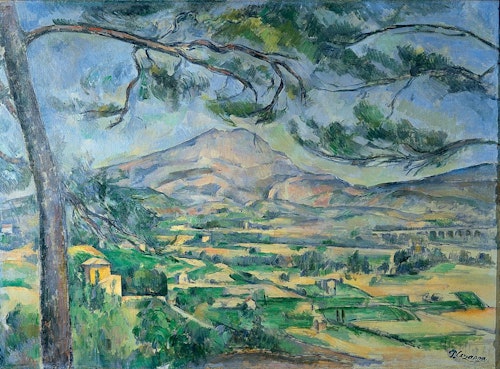
Mount Sainte-Victoire, 1887
Cézanne in his later years
In 1900, Maurice Denis, a painter of the Naviste School, published his "Laudation de Cézanne.
The painting depicts Cézanne's still life surrounded by his fellow Navists, including Denis himself, Vollard, and critics, standing facing the master Odilon Redon in the gallery of the art dealer Vollard. This work was exhibited at the Salon des Arts Nationales in 1901.
This still life by Cézanne was a favorite of Gauguin, who included it in his portraits as an in-painting.
This shows that Cézanne was still not well respected by the general public, but was highly admired by young painters.
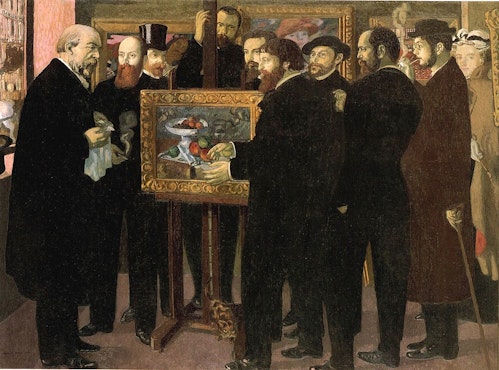
Maurice Denis, Cézanne Revered, 1900
Cézanne's Philosophy of Art
The painter Émile Bernard stayed with Cézanne in Aix for a month and later wrote in his memoirs.
Let me repeat what I have told you. I want to repeat what I have told you: to treat nature by means of cylinders, spheres, and cones, to put everything in perspective, so that each side of an object or plan is concentrated toward a single central point. Lines parallel to the horizon give an expanse, i.e., a section of nature. If you like, you could say it is a section of the scene that God the Almighty and Eternal Father unfolds before our eyes. Vertical lines give depth to this horizontal line. For us humans, by the way, nature exists more in depth than in plane. For this reason, we must include enough blue tones in the vibrations of light, indicated by red and yellow, to give the impression of air.
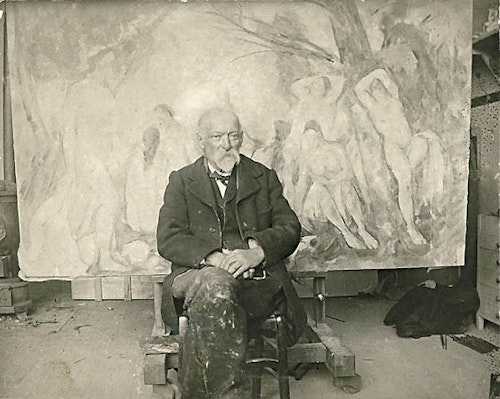
Cézanne sitting in front of The Great Bathing
Posthumous Recognition
For a while after his death, Cézanne's works were sold at a considerably lower price than those of Monet and Renoir.
After 1910, however, prices at auction began to soar, with works such as "Boy in a Red Vest" and "Portrait of an Old Woman with a Rosary" being purchased for over 30,000 pounds.
At the end of the 1980s, amidst the overall surge in the art market, there was a series of high-priced purchases by Japanese.
In 1989, "The Apple and the Napkin" sold at London Christie's for a record price of 10 million pounds (2,275.4 million yen, $15.78 million) and became the property of Yasuda Fire & Marine Insurance Co.
Later, in 2011, Qatar reportedly purchased "People Playing Cards" for over $250 million, the highest price ever paid for the work at the time, although details were not disclosed due to the relative nature of the transaction.
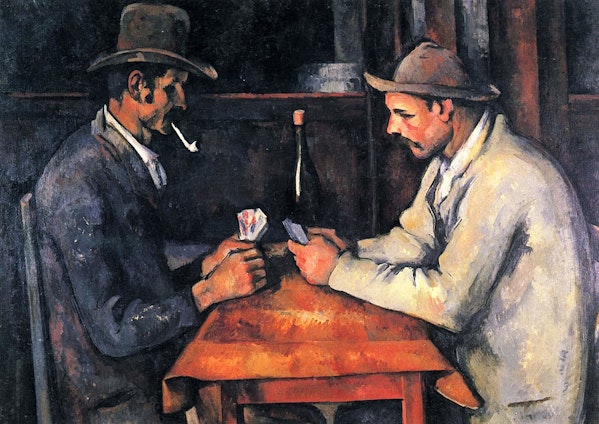
People Playing Cards, 1892-93
Paul Cézanne's Major Works
1. Victor Choquet in an Armchair, 1877
Cézanne is said to have spent an enormous amount of time posing and holding still with his models, and this portrait of Choquet is also said to have taken a considerable amount of time to complete. The artist paid close attention to geometric elements such as the angles of the straight lines of the arms created by the loosely connected hands and the triangles formed by the crossed legs and the four sides of the picture plane.
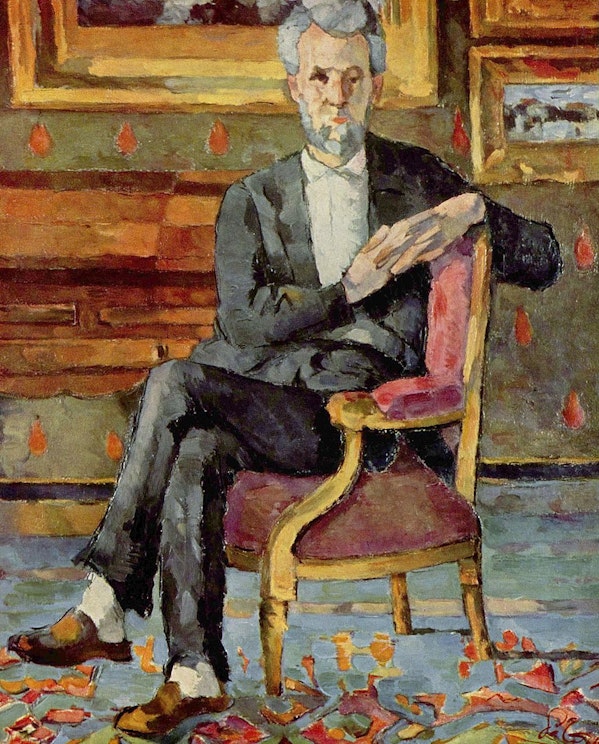
2. still life with apples and oranges, 1895-1900
Cézanne's still lifes of the 1880s show tense distortion.
By placing motifs seen from different angles on the same canvas, the effect is that the ridges of the table are at odds with each other. This was later appreciated and developed by Cubism. 3.
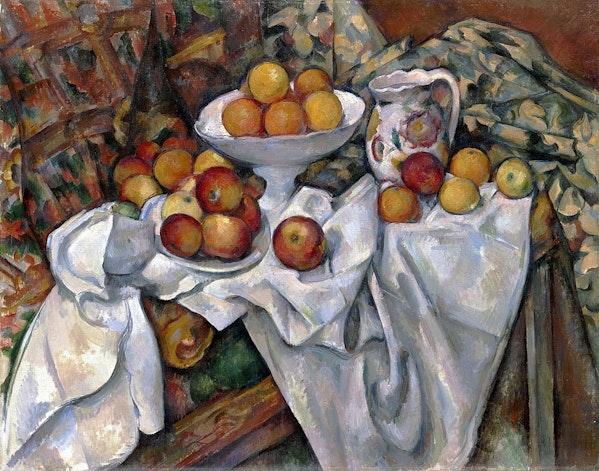
3. "Mount Sainte-Victoire" (1904)
While early Impressionist painters used color to convey instantaneous changes in tone and atmosphere, Cézanne's work is unique in that he aimed for solidity of form through the use of color.

4. the House at Medan, 1879-81
In this painting, Cézanne pursues order on the surface of the canvas by arranging short strokes in an orderly fashion within a composition of horizontal and vertical lines.
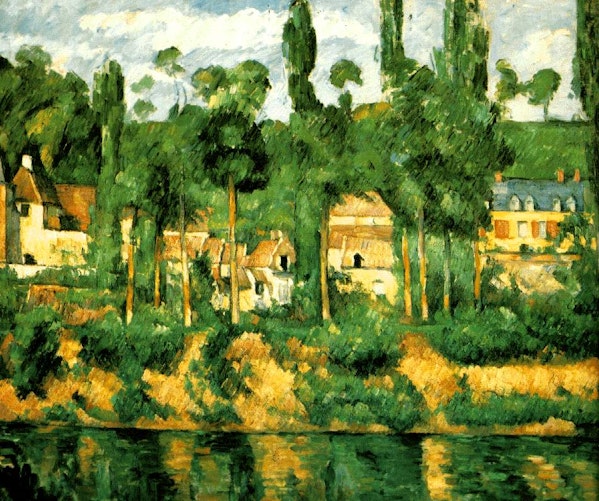
5. The Great Bathing, 1898-1905
Cézanne's early paintings were explicitly expressive of his inner Romantic sentiments.
After his encounter with the Impressionists, this explicit Romanticism seems to have faded into the background.
However, one theory suggests that Cézanne's life was a battle between trembling sensitivity and theoretical reason, and that the Romanticism that he detested kept sprouting, even showing up in his later paintings such as Bathers.
Cézanne's bathing paintings pursued nature, whereas Manet, Renoir, Monet, Degas, Toulouse-Lautrec, and others preferred scenes of modernizing Paris.
In Bathing, his orientation toward such a utopia is expressed. 6.
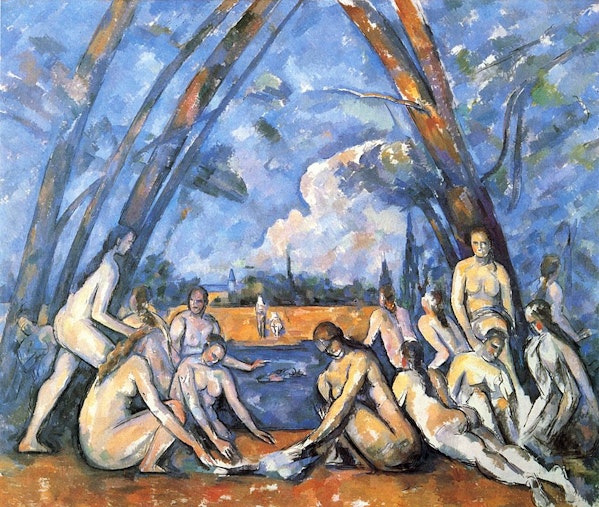
6. Boy in Red Vest, 1889-90
The boy's gently curving lines from his head to his blue trousers and his commanding right arm are opposed by the diagonal line of the table that extends from the edge of the sofa on the far right to the lower left.
The horizontal lines of the brown board in the background and the white wall below it add variety to a painting dominated by oblique lines.
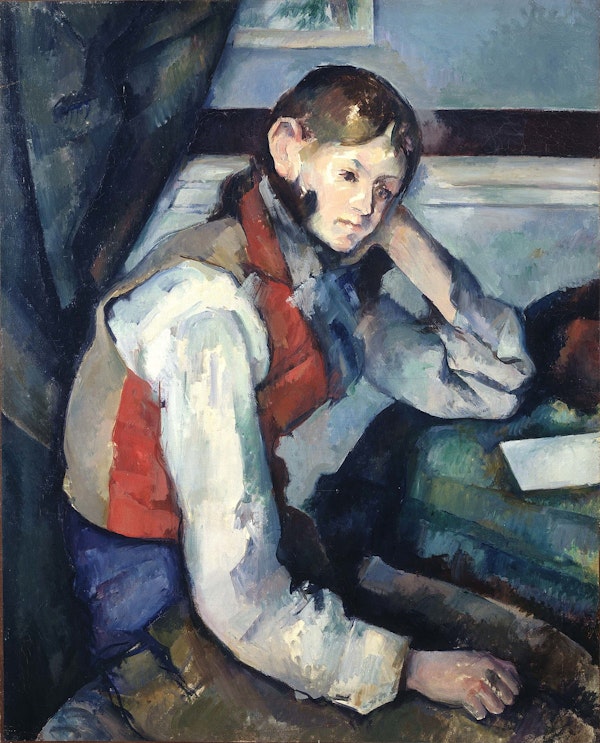
7. "Portrait of Ambroise Vollard," 1899.
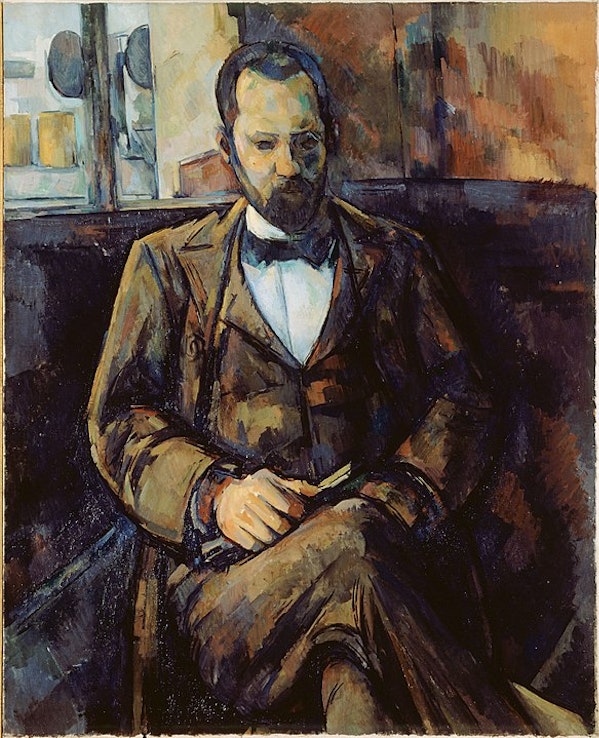
Portrait of Vollard by Renoir, 1908
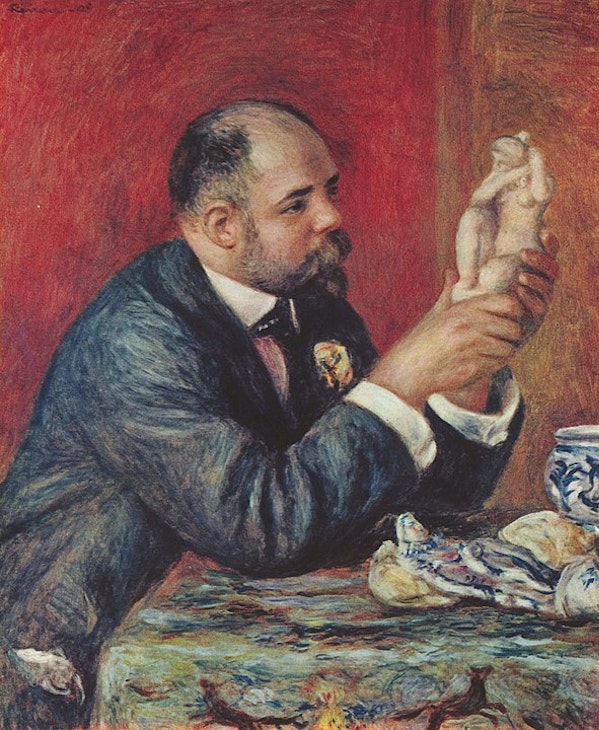
Unlike Renoir's warm portrait of the same Vollard, this work is more structured and devoid of superfluous detail.
For Cézanne, portraits are not about the life of the model as in Renoir's paintings, but about the human body with its volume in space, and in this respect, they have the same meaning as still-life paintings.
8. fruit and napkin, 1879-80
It is said that the artist spent so much time on the painting that the apples rotted and he ended up with only preliminary sketches.
Paul Sérusier, a painter of the Navier School, said of Cézanne's still life paintings, "He wanted the viewer to peel the skin and eat it,
"They do not make the viewer want to peel the skin off and eat it, but rather make the viewer want to copy the beauty of the work just by looking at it.
He described his paintings as "not making the viewer want to peel the skin off and eat it.
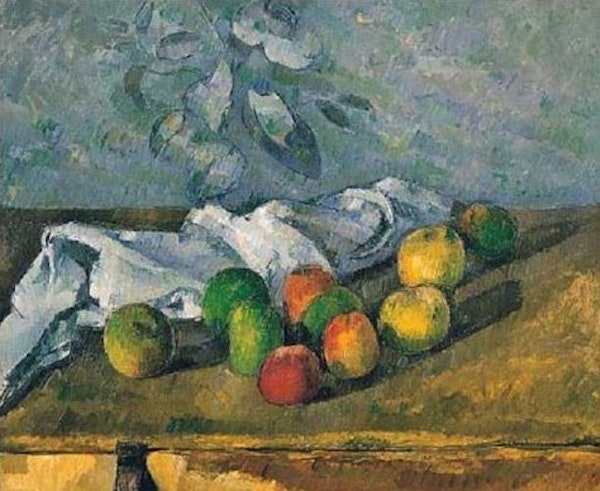
Kenta Nakajima's work in collaboration with Cezanne
Contemporary Japanese painter Kenta Nakajima has created works in which his pet Mucha is mixed in with the world of Cezanne's work.
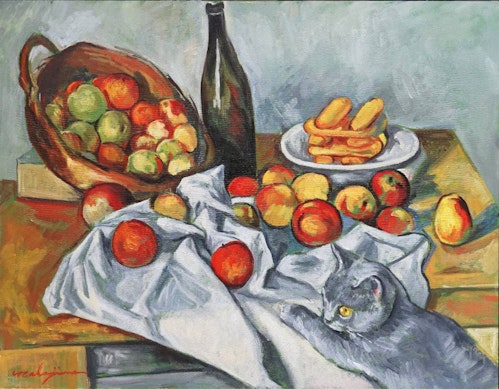
Traveling Mucha - Playing with Cézanne's Still Life by Kenta Nakajima
W 41.00cm x H 53.00cm
Also read
Please also read these articles related to Cezanne and Kenta Nakajima.
Art Course 2: Modern Art, Part 2: From Post-Impressionism to Contemporary Influence
Post-Impressionism: Paintings No One Has Seen Before
Who is Kenta Nakajima? An in-depth look at the famous works and prices of the sold-out artist
TRiCERA ART members receive a variety of special offers and preferences.
- Discounts, including members-only secret sales and coupons
- Create your own collection by registering your favorite artists
- Receive updates on popular artists, exhibitions, and events
- Receive a weekly newsletter with selected art
- Personal Assessment to find out what kind of art you like.
Please register as a member for free and receive the latest information.
Free Member Registration